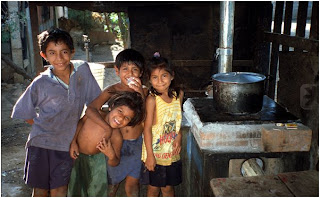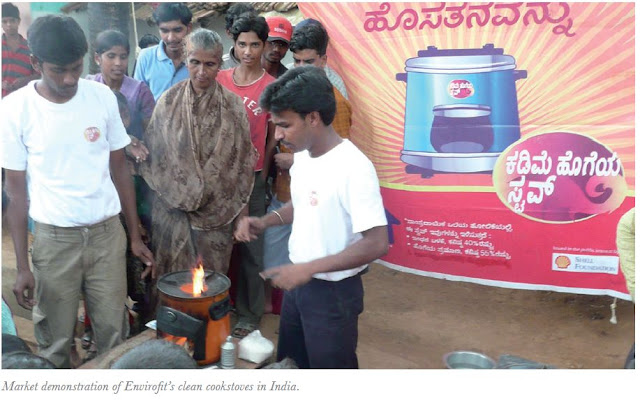Shell Foundation's milestone report
'Enterprise Solutions to Scale' propounds the cause of 'catalysing disruptive change through angel philanthrophy'. The approach propounded by Shell Foundation, and demonstrated through its programs, makes the point that angel philanthropy directed at new entities who are entrepreneurial and have aligned vision of scale are likely to be more successful in creating social impact.
According to the Report, "We find it striking that in every instance where partnerships achieved scale and measurable social impact it has been with newly created entities that we helped co-found using new business
models we co-developed. In all cases we were also the sole partner and subsidy provider during the development and testing of these business models. By contrast, despite our various efforts, we have never succeeded in helping an existing organisation go to scale. We believe that angel philanthropy has significant potential to catalyse scaleable solutions to global development challenges."
The Report echoes the belief that often underlines much of angel investing, saying "we look for entrepreneurial partners who focus entirely on the venture and share the start-up risk by investing their own resources in it."
According to the report, "It is hugely important to have an aligned vision with partners, from the outset, with respect to achieving scale and sustainability. This means having a plan to achieve both social impact and financial viability from inception and which is subject to regular measurement and reporting. It is also based on recruiting the best staff and developing the most efficient operating systems essential for managing the complex multiple location operations that scale entails. Where we have partnered with individuals or organisations who did not share this early ambition to achieve scale, we found it virtually impossible to “retrofit” the subsequent capacity needed to achieve it."
Exploring the issue of which are the best partners to invest in from a social point of view, the report points out that the Foundation made a strategic shift and had "far greater success... when we focused our resources – time and money – on developing new approaches with a few carefully selected partners or by supporting organisations with a clear market demand for the products or services they offered."
Further, the report makes the point that the approach has to go beyond simply providing funds: "We believe there is a need to deploy resources to build a sustainable enterprise rather than simply provide grants to subsidise the short-term provision of products or services. Building sustainable enterprises means investing in core capacity and systems as a pre-requisite for scale. It also requires additional input over and above grant finance in the form of business advice, market access and appropriate governance support."
Accordingly, "SF has invested considerable time in providing a range of expertise, business advice and skills-based support to our partners. We believe that this “more than money” approach forms a critical part of our differentiated business model and serves to significantly reduce the risk of working in a start-up environment."
The report takes a look at Shell Foundation's IAP Strategy and the way in which the strategies were changed in order to create greater social imact. Says the report, "By 2007, SF had invested over US$4 million in nine pilots with a range of IAP-specialist NGO partners across the globe. While this resulted in significant sales of improved cookstoves, no pilot showed the potential for scale-up or sustainability. As a result, we changed strategy and sought a global strategic partner with a proven track record in product design coupled with commercial experience in the marketing, distribution and sale of consumer durables."
Outlining its partnership with Envirofit, the report says, "From the outset, SF and Envirofit worked together to develop a viable business model, conduct in-depth consumer market research, undertake ground-breaking R&D in product development and establish distribution and sales networks with an initial focus on southern India. Envirofit has subsequently produced a line of durable clean cookstoves that currently retail for between US$15-US$30 in India.
Excerpts from the section on the partnership with Envirofit to deal with the challenge of IAP:
Compared to traditional cooking fires, these reduce emissions, improve fuel efficiency, and are perceived to reduce cooking time significantly. A recent independent study in India has rated the stove as the preferred one as it is modern looking, has high fuel efficiency, uses traditional fuel and is portable and smokeless.
Envirofit has recently produced a clean charcoal burning stove which is now being sold in Africa and other developing countries. As part of wider efforts to enhance sales of clean cookstoves, SF developed and implemented local and national IAP awareness-raising campaigns (“Room to Breathe”), and established a range of effective distribution channels through partnerships with microfinance institutions and NGOs. It has also supported Berkeley Air Monitoring Group (www.berkeleyair.com) to conduct independent monitoring of the performance of the stoves.
Recent field work in India concluded that the Envirofit stoves showed statistically significant reductions of PM2.5, CO2 and fuel use. Additionally, 78% of users reported that cooking time was reduced compared to their traditional stove, 89% reported that the improved stove saved fuel and 97% found the improved stove easier to use.
Over the period 2007 to date, Shell Foundation has committed US$12.3 million as grant funding towards the development of a range of clean cookstoves as well as building up the capacity and operational systems of both Envirofit International and Envirofit India. In 2010 Envirofit started expanding into Africa and is expected to scale up further in 2011.
Since early 2008, Envirofit has evolved into the market leader in sales of clean cookstoves across India. Aggregate sales to date of more than 150,000 stoves benefit an estimated 600,000 IAP affected people. With a durability of 3 to 5 years depending on the model, stoves sold to date are predicted to save over US$30 million for India’s lowest-income consumers through fuel-saving of over 600,000 tonnes of wood and preventing one million tonnes of carbon from entering the atmosphere. The business has also created over 500 local jobs through the growth of its 400-strong network of manufacturing, sales and distribution channel partners.

Envirofit has succeeded in creating a sustained and growing market for its clean cookstove products in India. As market growth continues, Envirofit will shift further towards localised assembly and manufacture so as to continue efforts to lower end user costs. As with many other types of consumer durable products aimed at the Bottom of the Pyramid, it takes a long time for this high volume, low margin business to reach the tipping point whereby sales growth is generated largely through brand awareness. Despite increasing earned income and improving gross margins, Envirofit will rely upon grant funding in its continuing efforts to both develop and market better performing and cheaper stoves until it achieves financial break-even expected in 2014.
In line with meeting agreed Key Performance Indicators, SF will continue to support Envirofit with regards to its own global scale-up plans for clean cookstoves. SF is also a founding partner in the Global Alliance for Clean Cookstoves, hosted by the UN Foundation to establish international standards and testing protocols for clean cookstoves, fund related health and climate research, and develop innovative financing mechanisms that aim to create a thriving global market for clean and efficient cooking solutions such as clean cookstoves and fuels. Their “100 by 20” goal is: 100 million households to have adopted clean and efficient cooking solutions by 2020.
Read the full report: Enterprise Solutions to Scale







































